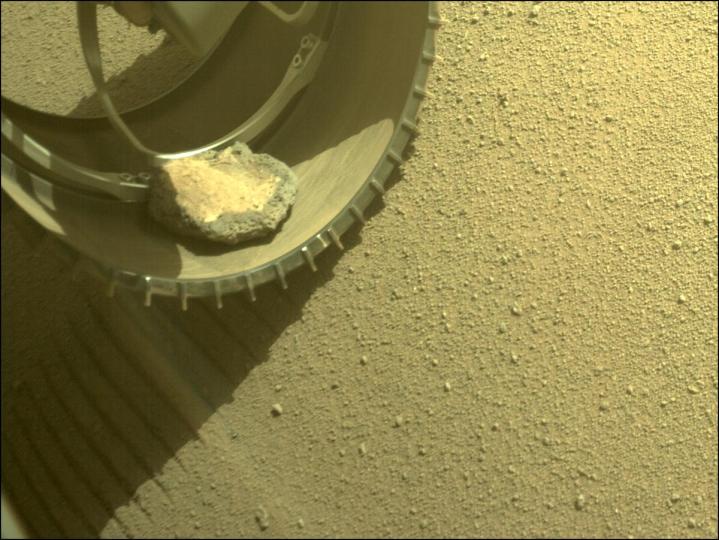It’s a lonely life for a rover on Mars, but the Perseverance rover has some company now in addition to its helicopter buddy Ingenuity. Perseverance picked up a rock hitchhiker which has been riding in the rover’s wheel for the past four months.
NASA recently shared the news in a blog post that described how a chunk of Martian rock had snuck into the rover’s front left wheel back in February this year. The rock was imaged by the rover’s front left hazard avoidance camera on February 6, and a second image taken on May 26 showed the rock still in the same wheel.

Happily, the rock doesn’t seem to be doing any harm as it bounces around inside Perseverance’s wheel, though it has stayed in place for a remarkably long time given how much it must have been jostled about — especially considering Perseverance has recently been booking it across the Martian surface and breaking records for longest drive by a martian rover in a single day.
In its time with the rover, the little rock has traveled more than 5.3 miles, leading to being charmingly dubbed Perseverance pet rock. “This rock isn’t doing any damage to the wheel, but throughout its (no doubt bumpy!) journey, it has clung on and made periodic appearances in our left Hazcam images,” writes Eleni Ravanis, a student collaborator with NASA.
Rocks inside a rover’s wheels, in this case, can be considerably less dangerous than the rocks outside the wheels. The rover Curiosity suffered damage to its wheels early in its mission when the treads were torn up by sharp rocks. Eventually, the holes and tears in the wheels lead to two of the treads of one wheel breaking off completely. To prevent further damage to Curiosity’s wheels, the rover recently changed its planned course to avoid more of these sharp rocks.
The damage to Curiosity’s wheels inspired changes to Perseverance’s design. Perseverance’s wheels are slightly different from Curiosity though the bodies of the two rovers are very similar. For Perseverance, engineers used a different tread pattern with gently curved treads placed close together, instead of Curiosity’s chevron treads which are placed further apart. This lets Perseverance have the same grip on rocky surfaces, but with a lower chance of damage from sharp rocks.
As for how long Perseverance’s rock friend will stick around, it’s impossible to say. It could fall out while Perseverance climbs the rim of the Jezero crater, or it could keep the rover company for a long time. It’s nice to travel with friends.
Editors' Recommendations
- Final communications sent to the beloved Ingenuity Mars helicopter
- It’s exactly 20 years since a Mars rover took this historic image
- NASA is looking for volunteers for yearlong simulated Mars mission
- Yes, Perseverance is exploring an ancient lake bed but no, it hasn’t found signs of life (yet)
- NASA says goodbye to Mars helicopter Ingenuity after an incredible 72 flights




